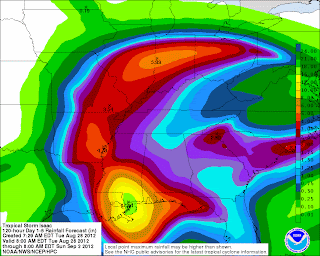Hurricane Isaac
After bypassing Tampa and thus failing to protest the Republican National Convention in any meaningful way, beyond having caused them to begin things a day late, Tropical Storm Isaac, now a hurricane though just barely, with winds just five miles over the lowest limit of 75 mph, has made landfall -- kind of, according to the latest blog update by Dr. Jeff Masters, the Weather Underground authority on such matters. He said that the storm wasn't moving very fast, and its center, at the time he wrote his update, which is dated just a few hours ago, was still over water, which suggests that it will intensify some more before it finally moves entirely over the land.
You don't see that often -- a hurricane just hanging there for a while, with one foot over the land and the other over the water. Usually, once they've decided to come in, they don't waste any time about it.
Dr. Masters also said this: The storm's large size and large 50 - 60 mile diameter eye kept the intensification rate slow today, but it came quite close to becoming a significantly more dangerous storm. That's because at landfall, Isaac was in the midst of establishing a small inner eyewall within its large 50-mile diameter eye, a very rare feat I've never seen before. Usually, when an eye first forms, it gradually contracts, eventually becoming so small that it becomes unstable. An outer concentric eyewall then forms around the small inner eyewall, eventually becoming the only eyewall when the inner eyewall collapses.
I don't quite understand what he said there, because it seemed to me that there wasn't that much difference between what Isaac is doing and the thing that he described as being what usually happens.
But it is almost 2 in the morning in my head and in my world.
Meanwhile, if you look carefully at the following highly colorful map, also found on Masters' blog and which shows the expected rainfall that Isaac is expected to bring to the country's midsection, you will notice that Virginia appears to be comfortably tucked away in the bend of the least affected areas, and so we here are not scheduled to get as much of as it as many other areas. Virginia hasn't been as lacking in rain as much of the rest of this drought-stricken country, and Isaac isn't expected to break the drought, but it will still help in a lot of places, and I still believe that, floods notwithstanding, in general it's much better to get too much water than it is to get little or none.

You don't see that often -- a hurricane just hanging there for a while, with one foot over the land and the other over the water. Usually, once they've decided to come in, they don't waste any time about it.
Dr. Masters also said this: The storm's large size and large 50 - 60 mile diameter eye kept the intensification rate slow today, but it came quite close to becoming a significantly more dangerous storm. That's because at landfall, Isaac was in the midst of establishing a small inner eyewall within its large 50-mile diameter eye, a very rare feat I've never seen before. Usually, when an eye first forms, it gradually contracts, eventually becoming so small that it becomes unstable. An outer concentric eyewall then forms around the small inner eyewall, eventually becoming the only eyewall when the inner eyewall collapses.
I don't quite understand what he said there, because it seemed to me that there wasn't that much difference between what Isaac is doing and the thing that he described as being what usually happens.
But it is almost 2 in the morning in my head and in my world.
Meanwhile, if you look carefully at the following highly colorful map, also found on Masters' blog and which shows the expected rainfall that Isaac is expected to bring to the country's midsection, you will notice that Virginia appears to be comfortably tucked away in the bend of the least affected areas, and so we here are not scheduled to get as much of as it as many other areas. Virginia hasn't been as lacking in rain as much of the rest of this drought-stricken country, and Isaac isn't expected to break the drought, but it will still help in a lot of places, and I still believe that, floods notwithstanding, in general it's much better to get too much water than it is to get little or none.




0 Comments:
Post a Comment
<< Home